 I recently traveled to Portugal on a catalogue photoshoot to uncover the best things to see and do for the retailer TravelSmith. I spent 11 days in this amazing place, from the southern coast of The Algarve to the historic northern city of Porto. Here are 9 things to see and do in Portugal:
I recently traveled to Portugal on a catalogue photoshoot to uncover the best things to see and do for the retailer TravelSmith. I spent 11 days in this amazing place, from the southern coast of The Algarve to the historic northern city of Porto. Here are 9 things to see and do in Portugal:
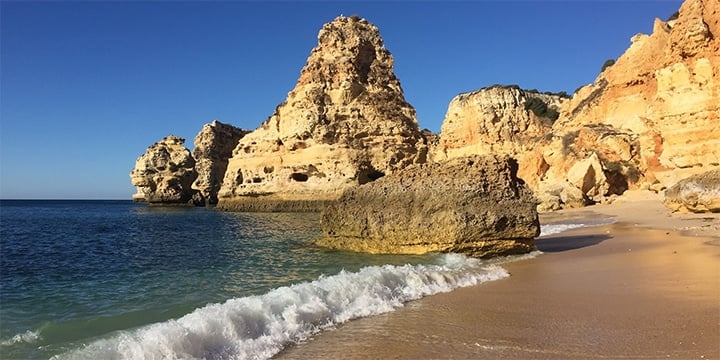 1. Praia de Benegil, The Algarve
1. Praia de Benegil, The Algarve
The Algarve, Portugal’s southernmost region, is known for its golden sand beaches, striking sandstone cliffs and clear Mediterranean waters. One of the most popular beaches is Praia da Marinha, located near the town of Lagos. The beach here is spectacular with plenty of room to sunbathe and set up camp for a day in the water. The surrounding cliffs are absolutely stunning and worth the trip themselves, just be careful not to sit too close; the cliffs are sandstone and can crumble at any time.
The best part about Praia da Marinha is its sea cave. Located around the point from the beach, the massive cave features two openings big enough for boats to pass through, and a 50-foot diameter hole at the top that acts as a natural sunroof. The cave is accessible by tour boats, which you can purchase tickets for at the beach, or if you’re a strong (and I mean strong) swimmer, you can make the trek yourself. Boat is the recommended method due to the strong current in the area, and once you’re inside, it feels like you’ve reached a different world entirely. The enclaved sandstone ceiling is surreal with numerous layers and colors, the water is pristine blue and the sand is soft and golden.
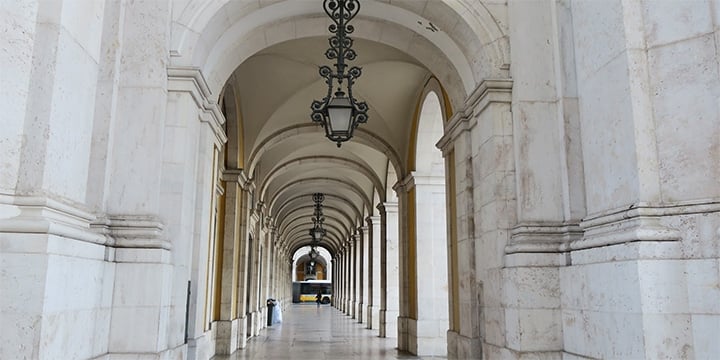 2. The Port of Lisbon
2. The Port of Lisbon
Lisbon is home to many historical sites including churches, towers and castles, but where to start? The Port of Lisbon is a must-see, with its beautiful square overlooking the Tagus River. Across the street from the water, travelers can wander through the main square featuring the Lisbon Baixa monument and Praça do Comércio, with its famous 18th century arcades. If you’re an early riser, get here just before sunrise for spectacular lighting and no crowds.
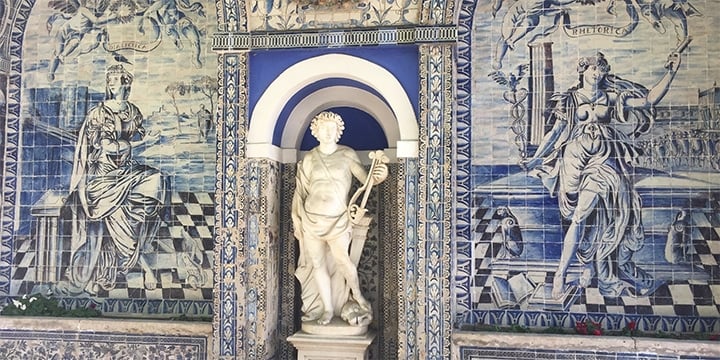 3. Palace of the Marquises of Fronteira, Lisbon
3. Palace of the Marquises of Fronteira, Lisbon
Hidden away from the city center is an ancient palace full of mystery and history of sin. The Palace of the Marquises of Fronteira was built in 1671 as a hunting pavilion to Dom João de Mascarenhas, 1st Marquis of Fronteira. Although officially referred to as a hunting lodge, the palace was actually a place for nobility and the wealthy to party away from their families in town. There are numerous tile mosaics depicting scenes of debauchery and sculptures with cryptic messages, hinting at the true purpose for the palace. However, that all changed in 1775 when the great earthquake demolished the city and the palace became the official residence of the royal family. The palace is open daily for tours and worth a visit.
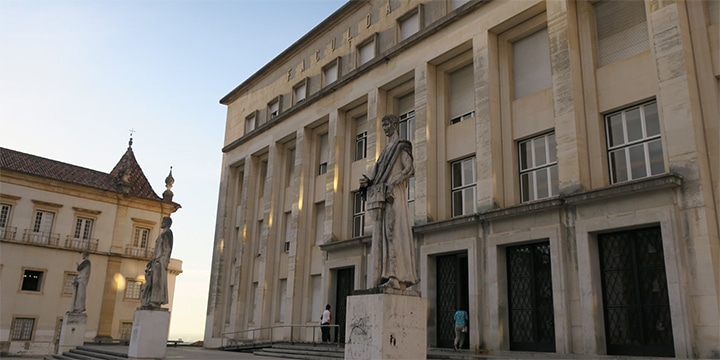 4. The University of Coimbra
4. The University of Coimbra
Located in central Portugal, Coimbra sits on a hillside overlooking the banks of the Mondego River. The medieval city was once the capital and the former palace is now one of the most prestigious universities in all of Europe, educating future politicians, doctors and lawyers from around the world.
Founded in 1290 by King Dinis, the University moved between locations for many years until in 1537, King James III donated his palace grounds to provide a permanent settlement for higher education in Portugal. Europe’s elite still study here and visitors can wander the campus on their own to view its beautiful 16th century architecture and 18th century bell tower, or take a guided tour to learn about its fascinating history spanning over seven centuries.
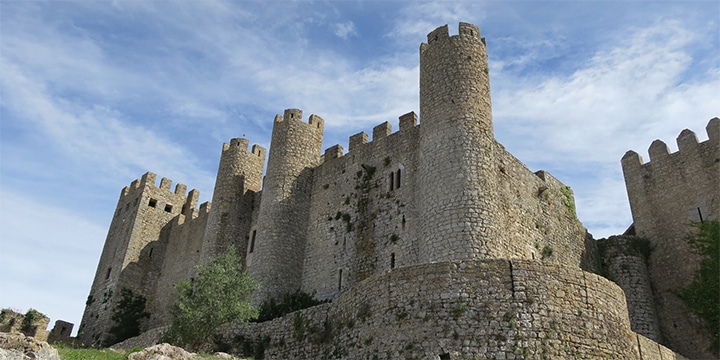 5. The Medieval Village of Óbidos
5. The Medieval Village of Óbidos
Óbidos is a beautiful and historic walled village dating back to Roman times, and after decades of war, was taken by Portugal from the Moors in 1148. It’s only an hour north of Lisbon, making it the perfect day trip for those looking to get out and see a medieval fortified city. One of the most picturesque towns in all of Portugal, Óbidos is filled with cobbled streets and traditionally painted houses, encircled by 30-foot high stone walls. The town is also historically owned by the Queen of Portugal so every house and shop is meticulously cared for and maintained, which is also why the town appears much as it did in the 12th century.
The town center is full of shops, restaurants and historical sights to explore. The main attractions are Castle Óbidos, located at the village’s highest point to oversee the surrounding area, and the Porta da Vila. The Porta da Vila is the main gate into Óbidos and is decorated by traditional ‘azulejos’ tiles that depict the Passion of Christ. The 12th century Santa Maria Church is also worth checking out and located in the town square. If you’re brave, take a walk along the border walls for the best views of the village, but use caution because the path is narrow, slippery and it’s a 30-foot drop to the street below.
 6. Port Tasting in Porto
6. Port Tasting in Porto
Nestled in the northwest corner of Portugal where the banks of the Douro River meet the Atlantic Ocean, Porto sits rich in history and culture. It’s famous for its bridges, including the Maria Pia Bridge designed by Gustave Eiffel (the guy who designed the Eiffel Tower) and a vibrant music and nightlife scene. But its most celebrated contribution to the world has to be the wonderful elixir, Port.
To be called Port, the grapes have to be grown in the Douro Valley, a two-hour drive east from Porto. It is here that the combination of dry weather, rocky soil and unique landscape combine to create the perfect growing conditions for Port grapes. To learn more about the process, history and characteristics of this time honored tradition, visit the world-famous Graham’s Port Lodge in town. Graham’s was established in 1820 and has an amazing winery where you can take tours of the cellar and barrel room and taste a variety of rare ruby, tawny and vintage ports. The tours are an hour long and end with a tasting. You can choose the level of tasting from basic flights to vintage reserves dating back to 1900.
After the tour, have lunch or dinner on the terrace with sweeping views of Porto and an award-winning menu to pair with your new favorite port. Their staff is extremely helpful and knowledgeable and will help you pair the right port with your food.
Port tasting is a must when visiting Porto and Graham’s is one of the largest, oldest and famous places of all to do it. I was told they have the best tour in town, and after visiting, I agree with that statement. Don’t forget to take home a bottle of vintage (only the best years are deemed “vintage”) or two; they’ll even wrap them up so they don’t break on the journey home. Cheers!
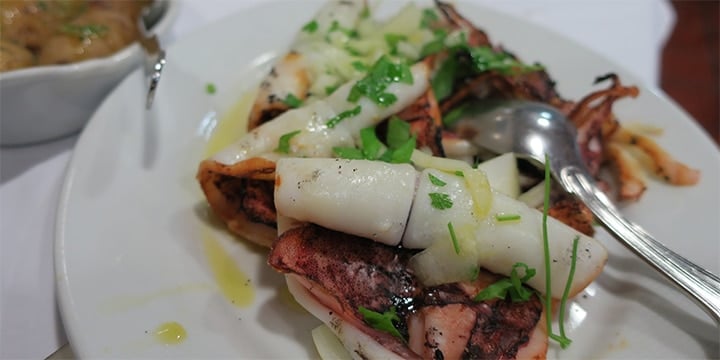 7. The Food
7. The Food
Portuguese-style cuisine is primarily made up of fresh seafood due to its proximity to the water, along with Portuguese sausage, and small plates similar to Spain’s tapas. Some favorites of ours were grilled octopus, cod, grouper and squid along with their famous ‘seafood rice.’ A mix between cioppino and a curry, seafood rice is awesome and features a light, tomato-based broth with rice, crab, clams, prawns, cod and a variety of spices … delicious! There are literally hundreds of amazing restaurants in town to try in Lisbon, but my favorite was Restaurant A Gina near the town center and on the grounds of a 100-year-old farmhouse. A Gina serves traditional Portuguese fare and is a great value. We highly recommend!
For something different than traditional Portuguese fare, try Jesus é Goês for the best Southern Indian food you’ll ever have outside of Goa. Owner and chef JesusLee, who got his name because his mother was a devout Catholic and his father was a huge Bruce Lee fan, uses only the freshest local ingredients available as the base for his innovative creations like fried chickpeas with shrimp samosas and marinated pork ribs in garlic paste and a savory-sweet-spicy sauce; JesusLee’s favorite entrée and the best Indian dish I’ve ever had. The menu contains a variety of classics from South India, but locals leave it up to the chef to guide them. Tell him what you like or leave it up to JesusLee completely for a little bit of everything, you won’t regret it. Make sure to arrive right when they open at 8pm or make reservations ahead of time, this place is always packed and for good reason.
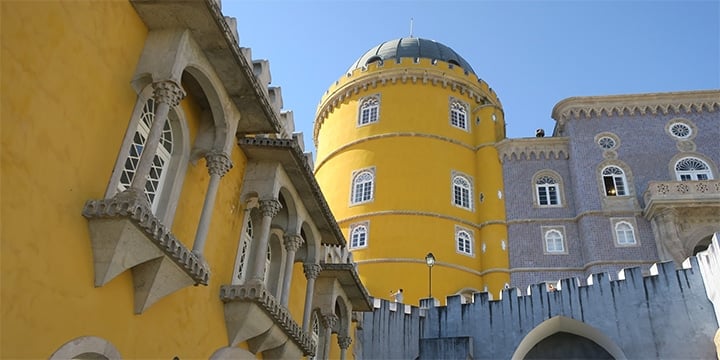 8. Pena Palace, Sintra
8. Pena Palace, Sintra
About 30 minutes outside of town is the town of Sintra, a resort town that is always full of tourists due to sweeping views of Lisbon and its numerous castles including the impressive Pena Palace. Sitting atop the Sintra Mountains, Pena Palace can be seen from Lisbon on a clear day and was the official summer residence for the Portuguese royal family until 1910. The palace is open daily to visitors and features opulent decor, intricate tile mosaics, and beautiful woodwork throughout its dozens of rooms, hallways and courtyards. The palace has been restored to show what it was like to live like Portuguese royalty in the 19th century.
 9. The City of Porto
9. The City of Porto
In addition to its rich history in port, the city of Porto itself is worth taking a day or two to explore its winding, hilly streets, bustling river banks and historical sites. If Lisbon is Portugal’s New York, Porto is San Francisco; smaller in size, cooler weather, and bursting with music and culture.
The city is split in two by the Douro River, with the south side home to the port wineries, but not much else. Both the southern and northern river banks are full of restaurants, but most are tourist traps and I’d recommend avoiding them. The magic of Porto runs through the streets and alleys of the hilly northern side, which are packed on any given night with local university students and foreign travelers. Whether you’re looking for a street party with a Dutch marching band, vibrant pub scene, live music or great restaurants, Porto has something for every night owl. During the day, after taking in the views of the Douro River on one of Porto’s famous bridges, check out the Mercearia Do Bolhao, a street market where you can find just about everything, or one of the many ancient churches like Igreja dos Clérigos or Church of St. Ildefonso. When you’re ready for a break from the hills, take one of the iconic cable cars around town (another thing in common with San Francisco). With such a variety of things to do and see, a couple days in Porto is a must for your trip to Portugal.

Great article! If you ever find yourself in Portugal again, be sure to visit Barcelos as soon as you can, it’s a small city but really lovely with a huge history, great food and a great nightlife.
The Rooster of Barcelos (Portuguese: “Galo de Barcelos”), in particularly, is one of the most common symbols of Portugal. Plus, the people there are so friendly, I difinitely recommend it!
Interesting article, but i was hoping to find more info regarding the Algarve. The Algarve (south of Portugal) is on summer time one of the most chosen destinations inside Europe specially for families holidays. As a main resident and travel agent based in the city of Faro i would advise to all the travelers to do a research for the most interesting cities (in my opinion) to visit in the Algarve described below.
Algarve Western Side:
– Albufeira
– Vilamoura
– Praia da Luz
– Praia da Rocha / Portimão / Alvor (same area)
– Lagos
– Silves
– Sagres
Algarve East Side:
– Faro
– Olhão
– Tavira
I would be very pleased on having a future article on Johnnyjet regarding one of this cities.
Happy Journeys….
Excellent read, I want to see The Medieval Village of Obidos so bad so thanks for bringing it to my attention!
A great article, but sorry to be a pain, there is a typo. It’s Praia de Benagil. Portugal is a great place indeed!